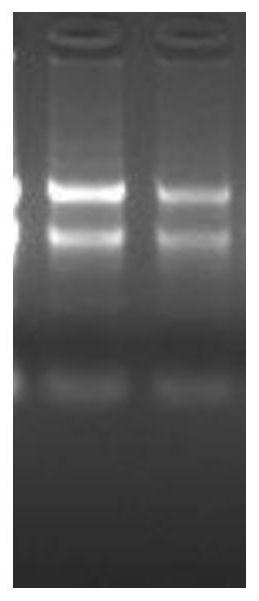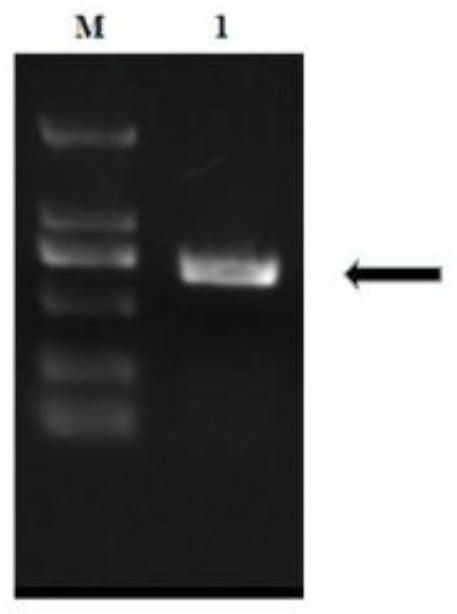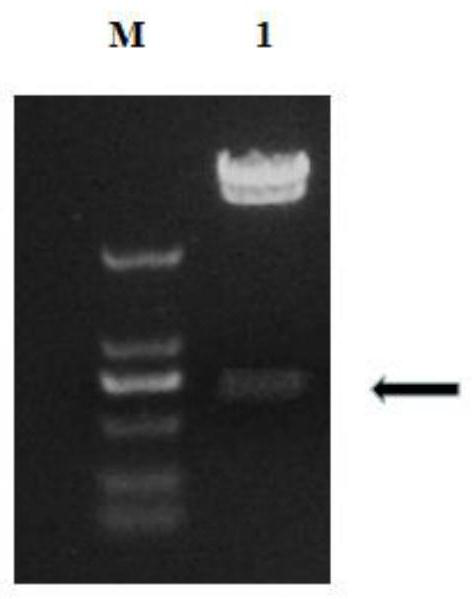Construction and application of an anti-sclerotinia gene gmgst1 and gmgst1 transgenic plant
A technology for sclerotinia and plants, applied in the field of plant genetic engineering, can solve the problems of scarcity of genetic resources, restriction of efficiency and accuracy of new variety breeding, complicated mechanism of soybean anti-sclerotinia, and achieve the effect of improving resistance
- Summary
- Abstract
- Description
- Claims
- Application Information
AI Technical Summary
Problems solved by technology
Method used
Image
Examples
Embodiment 1
[0030] Example 1. Obtaining the antibacterial sclerotinia gene GmGST1.
[0031] 1) Using the soybean antibacterial sclerotinia cultivar Maple Arrow as the material, when the first group of three-leaf compound leaves grows, the material is taken and the total RNA is extracted, and the results are as follows figure 1 shown, and reverse transcribed to synthesize the first strand of cDNA.
[0032] 2) According to the GmGST1 gene sequence on Phytozome, utilize Primer 5 software to design gene cloning primers,
[0033] Primer 1-S: 5'-AGATCTATGCCGTTACCTTCTCAAAT-3', the sequence is as shown in SEQ ID NO.2;
[0034] Primer 1-a: 5'-GGTTACCTTAGATTTTGTTGAATGCAAC-3', the sequence is shown in SEQ ID NO.3.
[0035] Using cDNA as template PCR reaction, the reaction system is as follows:
[0036]
[0037] Reaction program: 94 °C for 5 min; 37 cycles: 94 °C for 30 s, 54 °C for 30 s, 72 °C for 40 s; 72 °C for 10 min, and 4 °C storage. After the reaction, the PCR products were taken for 1%...
Embodiment 2
[0039] Example 2. Construction of antibacterial sclerotinia transgenic soybean plants.
[0040] (1) construct overexpressing GmGST1 gene recombinant vector, the concrete steps are as follows:
[0041] The plasmid pCambia3301 and the pGM-GmGST1 prepared in Plasmid Example 1 were digested with BstEII and BglII, respectively. After detection by agarose gel electrophoresis, the pCambia3301 vector backbone and the GmGST1 gene digested fragment were recovered and purified, and the two fragments were connected and transformed. The picked single spot was identified by BstEII and BglII double enzyme digestion, and the recombinant vector pCambia3301-GmGST1 carrying the GmGST1 gene was obtained. The enzyme digestion identification results are as follows image 3 shown.
[0042] (2) The recombinant vector constructed in step (1) is introduced into Agrobacterium to obtain the recombinant bacteria with GmGST1 gene, and the specific steps are as follows:
[0043] The pCambia3301-GmGST1 exp...
Embodiment 3
[0052] Example 3. Construction of antibacterial sclerotinia transgenic soybean plants.
[0053] Example 2 was repeated, and the difference from Example 2 was that the seeds used in 2) in step (3) of this example were soybean variety Hefeng 25. In this example, a total of 16 T0 generation positive plants were obtained.
PUM
| Property | Measurement | Unit |
|---|---|---|
| concentration | aaaaa | aaaaa |
Abstract
Description
Claims
Application Information
 Login to View More
Login to View More - R&D
- Intellectual Property
- Life Sciences
- Materials
- Tech Scout
- Unparalleled Data Quality
- Higher Quality Content
- 60% Fewer Hallucinations
Browse by: Latest US Patents, China's latest patents, Technical Efficacy Thesaurus, Application Domain, Technology Topic, Popular Technical Reports.
© 2025 PatSnap. All rights reserved.Legal|Privacy policy|Modern Slavery Act Transparency Statement|Sitemap|About US| Contact US: help@patsnap.com



